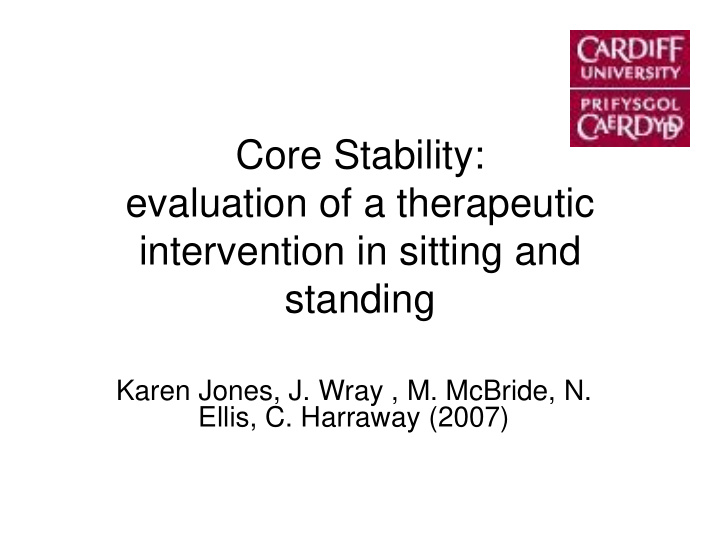



Core Stability: evaluation of a therapeutic intervention in sitting and standing Karen Jones, J. Wray , M. McBride, N. Ellis, C. Harraway (2007)
Background • Poor Core stability in athletes – less efficient movement and potential injury (Fredericson and Moore, 2005) • Core stability training – prevents injury (Feaver, 2001) – enhance performance (Comerford, 2004) – accelerate post injury rehabilitation (Comerford, 2004)
Background • Local stabilisers more efficient – Anatomy (Bergmark, 1989: Richardson et al, 1999) – Segmental stabilisation (Richardson et al, 1999, Hodges and Moseley, 2003) – Co-contraction (Granata and Marras, 2000) (Kavcic, 2004) • Isolation of the local stabilisers comes from a neutral pelvis/ lumbar spine alignment (O’Sullivan, 2002: Cholewicki, 1997) (O’Sullivan, 2006 ) • Rehabilitation – Isolate/ Dynamic mvt/ Function
Present research - Aim • Investigate any change in bilateral SEMG activity of the trunk stabilisers between upright posture and post facilitation of an active neutral spine – Sitting – Standing • No existing evidence of effectiveness
Method • Design – Same subject experimental design • Sample (N=22) (females = 19) – Convenience sample – Healthy – Age group (mean 21.9 yrs) • Local ethical approval gained/ Data Protection Act (1998)
Method - measure • Measurement tool – Surface EMG – Pre and post intervention – ESLT, EO, LMT, TA/IO • SEMG bipolar configuration bilaterally. – skin prep (Turker, 1993) – electrode placement (Freriks, 1999) • Same day standard protocol – Intra tester reliability for abdominals (Ng et al, 2003 - ICC = 0.75-0.89) – Reliability for back muscles ( – MVC (Dankaerts et al, 2003 – ICC 0.91)
Electrode placement EO ground electrodes EO electrodes TA/IO electrodes TA/IO ground electrode ESLT ground electrode ESLT electrodes LMT electrodes LMT ground electrode references
Intervention • Start position – Standardised • Intervention – Pragmatic approach • Evaluation of active neutral spine – Visual – Palpation
PRE INTERVENTION
INTERVENTION
POST INTERVENTION
Data processing/ analysis • Recorded over 3 seconds – RMS average requested • Normalised against the MVC • Repeated x 3 – mean calculated • Data analysis – Repeated measure ANOVA (post hoc t test) (p=≤0.05)
Results
SEMG investigation of facilitation technique in sitting 18 ** Pre ** 16 ** ** Facilitation 14 Post 12 SEMG (%MVC) facilitation 10 8 6 4 2 0 Left EO Right EO Left Right Left MT Right MT Left ES Right ES TA/IO TA/IO
SEMG investigation of facilitation technique in standing Pre ** Facilitation ** * Post * facilitation ** ** * *
Summary - Intervention • Results – Statistically significant increase in all core stabilisers with preferential recruitment of local over global muscles – In sitting there was a change from global strategy (baseline) to local strategy – In standing enhanced local strategy
Conclusions • Facilitation is useful for the initial stages of training core stability ie. learning to isolate the local stabilisers
Thank you for your attention Acknowledgements to: Research Centre for Clinical Kinesiology, Cardiff University Contact details - Email : joneskj@cf.ac.uk
Recommend
More recommend